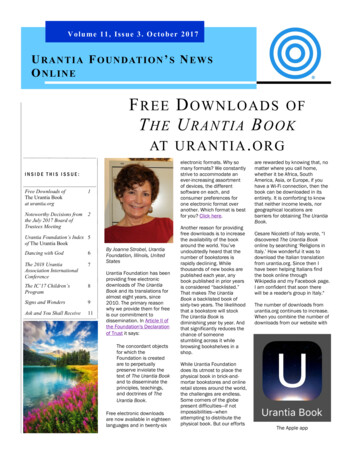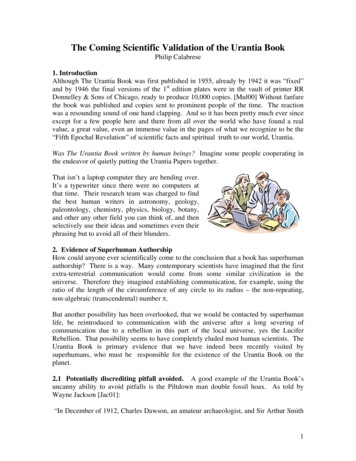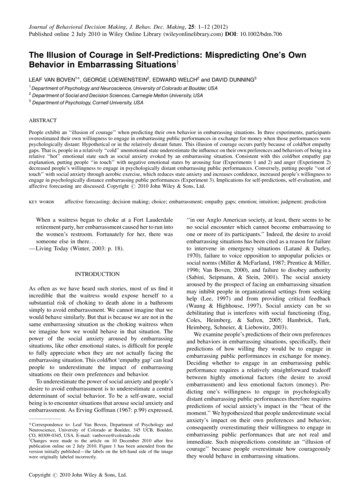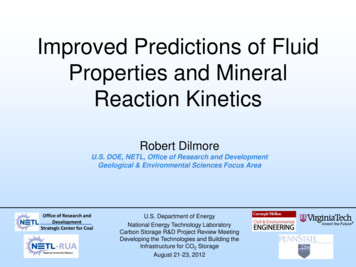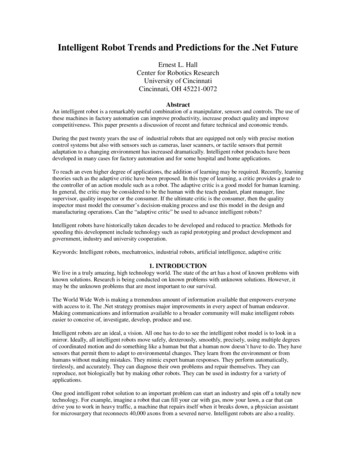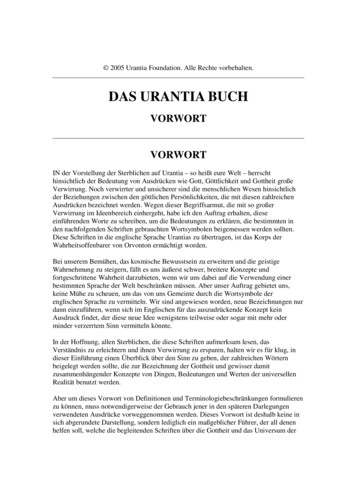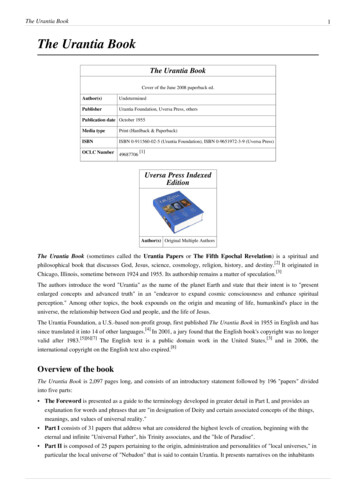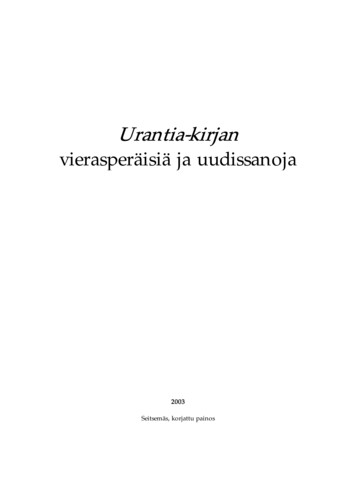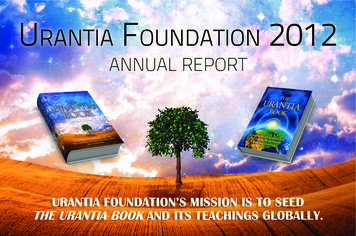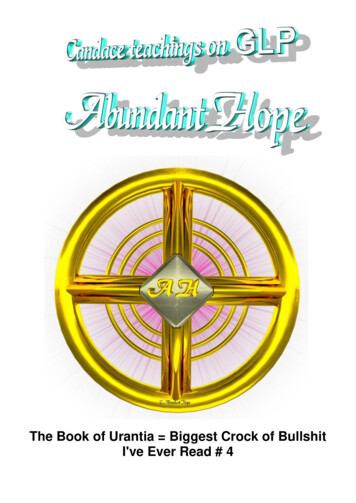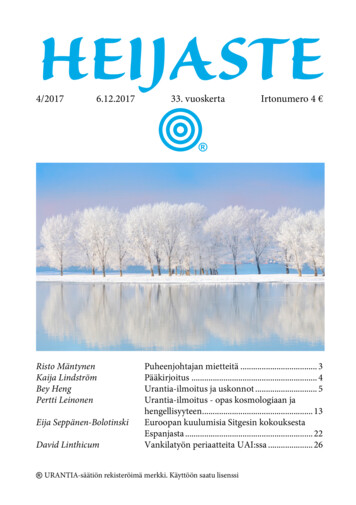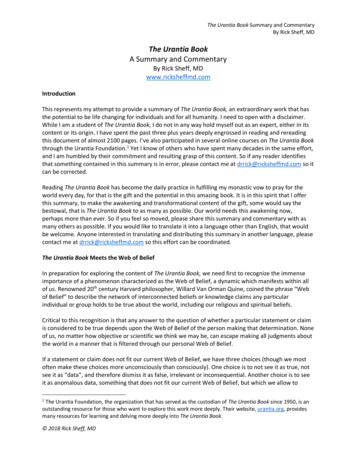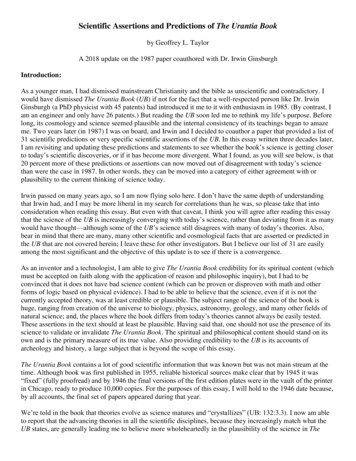
Transcription
Scientific Assertions and Predictions of The Urantia Bookby Geoffrey L. TaylorA 2018 update on the 1987 paper coauthored with Dr. Irwin GinsburghIntroduction:As a younger man, I had dismissed mainstream Christianity and the bible as unscientific and contradictory. Iwould have dismissed The Urantia Book (UB) if not for the fact that a well-respected person like Dr. IrwinGinsburgh (a PhD physicist with 45 patents) had introduced it me to it with enthusiasm in 1985. (By contrast, Iam an engineer and only have 26 patents.) But reading the UB soon led me to rethink my life’s purpose. Beforelong, its cosmology and science seemed plausible and the internal consistency of its teachings began to amazeme. Two years later (in 1987) I was on board, and Irwin and I decided to coauthor a paper that provided a list of31 scientific predictions or very specific scientific assertions of the UB. In this essay written three decades later,I am revisiting and updating these predictions and statements to see whether the book’s science is getting closerto today’s scientific discoveries, or if it has become more divergent. What I found, as you will see below, is that20 percent more of these predictions or assertions can now moved out of disagreement with today’s sciencethan were the case in 1987. In other words, they can be moved into a category of either agreement with orplausibility to the current thinking of science today.Irwin passed on many years ago, so I am now flying solo here. I don’t have the same depth of understandingthat Irwin had, and I may be more liberal in my search for correlations than he was, so please take that intoconsideration when reading this essay. But even with that caveat, I think you will agree after reading this essaythat the science of the UB is increasingly converging with today’s science, rather than deviating from it as manywould have thought—although some of the UB’s science still disagrees with many of today’s theories. Also,bear in mind that there are many, many other scientific and cosmological facts that are asserted or predicted inthe UB that are not covered herein; I leave these for other investigators. But I believe our list of 31 are easilyamong the most significant and the objective of this update is to see if there is a convergence.As an inventor and a technologist, I am able to give The Urantia Book credibility for its spiritual content (whichmust be accepted on faith along with the application of reason and philosophic inquiry), but I had to beconvinced that it does not have bad science content (which can be proven or disproven with math and otherforms of logic based on physical evidence). I had to be able to believe that the science, even if it is not thecurrently accepted theory, was at least credible or plausible. The subject range of the science of the book ishuge, ranging from creation of the universe to biology, physics, astronomy, geology, and many other fields ofnatural science; and, the places where the book differs from today’s theories cannot always be easily tested.These assertions in the text should at least be plausible. Having said that, one should not use the presence of itsscience to validate or invalidate The Urantia Book. The spiritual and philosophical content should stand on itsown and is the primary measure of its true value. Also providing credibility to the UB is its accounts ofarcheology and history, a large subject that is beyond the scope of this essay.The Urantia Book contains a lot of good scientific information that was known but was not main stream at thetime. Although book was first published in 1955, reliable historical sources make clear that by 1945 it was“fixed” (fully proofread) and by 1946 the final versions of the first edition plates were in the vault of the printerin Chicago, ready to produce 10,000 copies. For the purposes of this essay, I will hold to the 1946 date because,by all accounts, the final set of papers appeared during that year.We’re told in the book that theories evolve as science matures and “crystallizes” (UB: 132:3.3). I now am ableto report that the advancing theories in all the scientific disciplines, because they increasingly match what theUB states, are generally leading me to believe more wholeheartedly in the plausibility of the science in The
Urantia Book.Looking back, we now know that the scientific information in the book generally agreed with the science of theday; in fact, much of the book seems to parrot the most advanced science of those times (as shown nicely byMathew Block’s work). On the other hand, some of it differed markedly from the scientific theories of 1935.One of Block’s findings in this connection is interesting: the celestial authors of the text omitted the errors ofthose human scientific authors from whom they were lifting and sifting quotes from the available science textsof that era, as one part of its policy of harvesting of human sources.As we proceed in this discussion, let’s keep these quotes in mind in thinking about the science of the UB:“The scientist, as such, is limited to the discovery of the relatedness of material facts. Technically, he has noright to assert that he is either materialist or idealist, for in so doing he has assumed to forsake the attitude of atrue scientist since any and all such assertions of attitude are the very essence of philosophy.” 132:1.2“Scientists may someday measure the energy, or force manifestations, of gravitation, light, and electricity, butthese same scientists can never (scientifically) tell you what these universe phenomena are. Science deals withphysical-energy activities; religion deals with eternal values. True philosophy grows out of the wisdom whichdoes its best to correlate these quantitative and qualitative observations. There always exists the danger that thepurely physical scientist may become afflicted with mathematical pride and statistical egotism, not to mentionspiritual blindness.” 133:5.4Limitations of Disclosure and TerminologyThe Urantia Book warns of the limitations on transmitting scientific ideas in a revelatory context. For example,in dealing with the future of scientific discovery, the terms that will be used in the future (and the precisedefinitions of these terms) are of course not known, and this may hinder clarity. For example, the bookdiscusses "continental drift" on the earth's surface, while science today talks only of "plate tectonics.” Also,today’s physicists use the term "meson" instead of the word “mesotron" used by the revelators.In addition, the book clearly states that there is a time limitation on the information that can be presented. Theyproclaim that they “can’t anticipate the discoveries a thousand years.” Further, they make clear that correlationsbetween their statements and current science will be possible, but they make clear that such revelatory scientificinformation is provided in the text only if we will soon be able to prove this fact or theory ourselves. Theconverse also seems to be true: they are permitted to share plenty of information about ideas or facts we couldnever humanly discover on our own (e.g., the unique concepts of the ultimaton and segregata, for instance).All that said, here are the 31 items from the 1987 paper that we will now have a second look at:1.2.3.4.5.6.7.8.9.10.11.12.13.Healing chemicals for woundsPlate tectonics or continental driftSource of the sun's energyTemperature at center of sunMajor Energy of SpaceCreation of the sunLocation of Seven Superuniverses in the Grand UniverseCreation of the Earth and moonChemical element with atomic number 101Neutrino particleMass of the meson particleCreation of matter and energyCreation of our solar system
.31.Life implanted on Earth 550 million years agoEnd of Cretaceous ageBreakup of fifth planet from the sun (asteroids)Dark islands in the universeOrganization of matter in a superuniverseUse of DNA for human evolutionReduced gravity effect on calcium ionReduced gravity effect on unattached, and uncharged electronic-energy particlesOrigin of the sunspot cycleTwelve planets in our solar systemCause of wave action of lightSpeeds greater than the speed of lightTwo kinds of gravityAntigravityUnknown form of energyUltimaton particleNeanderthal to Cro-Magnon transitionLife Span of an Ordinary StarLet’s update each of these assertions and predictions. (Note that I list the scientific category or categories andthe pertinent section in the UB for each item):1. Healing chemicals for wounds (medicine, biology; 65:4.3-5)The Urantia Book briefly describes the natural process by which an injured cell can heal itself by eliciting fromits neighboring cells “the secretion of certain substances which facilitate healing processes in the wound.” Itfurther states that these healing chemicals for wounds will later be understood by our scientists. At the time ofits writing, chemicals that fight infection and thereby speed up the healing process were indeed in the process ofbeing discovered. Penicillin was discovered in 1928, but serious work on its properties did not start until tenyears later; sulfa drugs (synthetic antimicrobial agents) were discovered in 1935 but didn’t come into use untilfive years later. These substances may or may not relate to the healing chemicals the UB refers to that involvethe cells themselves, but I am giving this one thumbs up as these drugs emulate the cells’ own healing process. Ishould add that the book also hints at other discoveries of this type that will be made in the future. (See 65:4.3.)Recent advances in the areas of connective and soft tissue diseases and damage have led to vascularization andcollagen-enhancing drugs to promote healing at the cellular level and we now have numerous immune-systemstimulants and suppressants drugs, and my personal favorite: the cancer-killing chemical known as 3bromopyruvate which works at the mitochondria level of the cells.2. Plate tectonics or continental drift (geology, geophysics; 58:5)Perhaps one of the most notable scientific claims of the UB that was proven after its publication is its teachingthat the continents drift slowly over the surface of the Earth. This general thesis had been proposed in the earlyyears of the twentieth century, but by 1935 no significant evidence for the drift of the continents had beenfound. While it is true that a look at the shape of the east coast of South America and the west coast of Africareadily shows the ancient fit between these two land masses, science requires material proof. Such proof onlycame in 1969 by matching subsurface earth layers on the two continents, along with the discovery of oceanfloor cracks between the continents. These trenches at the bottom of the oceans generate the energy thatpropagates the slow movement of the plates on either side in opposing directions. We give this a “yes” for avalid prediction, there there is one remaining discrepancy: the book states that the drift started about 700 millionyears ago, while it was recently computed by geologists to have begun 200 million years ago, based on theoldest ocean rocks that have been found at the bottom of the Atlantic Ocean.
3. Source of the sun’s energy (physics, astrophysics; 41:8.1–2)The book says that the sun generates energy by fusing four hydrogen atoms to form one helium atom, usingcarbon as a catalyst. This process, known as nuclear fusion, is a form of mass-to-energy conversion thatliberates huge amounts of energy in the form of heat and luminosity. Physicists worked out this understandingof the sun’s energy conversion process about the time the Urantia Papers were finalized.4. Temperature at the center of the sun (physics, astrophysics; 41:7.2)The UB states that the temperature at the center of the sun is 35 million degrees Fahrenheit. In the mid-1930s,science had only guessed at a temperature of millions of degrees, but an estimate of 29 million degrees wasmade in the late 1930s. Today we have an accurate and reliable measurement because of the work of the Solarand Heliospheric Observatory (SOHO) satellite, which was first launched in 1995 and has ever since beenorbiting the sun. The SOHO reading is 28 million Fahrenheit, not too far from the claim of the Urantia text.Side note while we are talking about predictions involving the Sun:Density of the sun (physics; 41:4)The Urantia Book says “The mass of your sun is slightly greater than the estimate of your physicists, whoreckoned it as about 2 octillion (2 x 1027) tons.” The current SOHO data puts the sun’s mass at 2.2 x 1027 tons.This latest measurement by the SOHO satellite corroborates the claim made in the UB in 1935.Surface temperature of the sun (stellar physics, 41:7)The book says that the surface temperature of the sun is “almost 6,000 degrees” Fahrenheit. Today’s sciencemeasures the temperature as 9,941 degrees Fahrenheit. But it should be noted that there is contention as to whatexactly is the “surface” of the sun. Science has identified five principal zones: the temperature minimum region,the chromosphere, the transition region, the corona, and the heliosphere. The chromosphere, transition region,and corona are much hotter than the surface of the Sun. The coolest layer of the Sun is the temperatureminimum region about 500 km above the photosphere, with a temperature of about 4,100 K or 6,900 F5. Major Energy of Space (Physics, 41:9)The book said that science did not know about energy pervading space in 1935. This energy apparently flowsthrough space in circuits. It could be referring to the strong nuclear force which science now knows about, andwhich is involved in the conversion of mass to energy in the stars. It could also suggest that the rope analogy ofenergy associations is real.6. Creation of the sun (cosmology, stellar physics; 57:1, 5:7.5.1)The book says that the sun originated from an enormous cloud of dust and gas known as the Andronovernebula, which disappeared long ago. Whereas science dates the universe as less about 14 billion years old, theUB states that the universe is far older, claiming for instance that the Andronover nebula that gave birth to oursun has undergone about 800 billion years of development. As this mother nebula contracted by the force ofgravity, the book says that it threw off over a million suns, a fact unknown to current science; also unique to theUB is the idea that our sun originated toward the far end of this epic process of “sun disgorgement.” Bothscience and the UB agree that the sun is of origin from a nebula and that, having been ejected, heated itselfbecause of gas compression due to gravity until the sun attained nuclear fusion status. This basic description ofour sun’s origin generally agrees with current science—except for the timing of nebular evolution that theUrantia text says preceded it, where there is of course a great discrepancy. The UB also says the sun’s creationoccurred about 6 billion years ago, whereas science puts it at 5 billion. We will give the book’s assertions about
the birth of the sun the designation of “possible” because science still has a distance to go to understand the ageof the universe.7.Location of Seven Superuniverses in the Grand Universe (Astronomy, 15:0.2 , 15:0.3)The book describes the seven superuniverses circling around Havona in a planar elliptical course. It also saysthat science has almost found superuniverse number seven and will find the rest soon. In 1935, science thoughtthat all the galaxies were uniformly distributed throughout space. The existence of large voids between galaxiesand the clustering of galaxies have only recently been discovered however the current structure is filamentary.If speed and distance measurements are flawed (by some of the Big Bang assumptions) the current filamentarystructure may show more potential for this organization. It is interesting to note that a Fourier or Möbiustransformation T1(z) 1zT1(z) 1z turns a filament into the circle (time, speed, distance) transform, turns afilament into a cluster. A couple of important notes here is that the organization is primarily administrative andthe we are now seeing movements of whole sections of the observable universe. If we also consider that thesemeasurements are based on the fundament assumption of the big bang and we replace that with spacerespiration (as Steven Hawkins noted that an alternate solution is that the universe has always been inexistence). The Big bang is under pressure currently as it does not allow enough time for the formation of largeblack holes. As Forbes Magazine reported in July 2018 “Gravitation hasn’t had enough time to pull matter intolarge enough clumps to have stars and galaxies .The Universe was so hot you couldn’t form neutral atoms andthen where even when matter-antimatter pairs spontaneously formed, individual protons and neutrons would bedissociated into quarks and gluons .A Universe filled with energy inherent to space itself, causes a rapid,exponential expansion, that stretches the Universe flat, gives it the same properties everywhere, with smallamplitude quantum fluctuations, that get stretched to all scales (even super-horizon ones) and then inflationcomes to an end.”8. Creation of the Earth and moon (astronomy, 57:6-7)The book says that the earth and the moon coalesced as a pair of twin planets after the giant Angona nebulacame close to the sun and pulled away enough material to form all the planets. (For further background, seeitem 12 below.) At first, the earth was about a tenth of its current size—at around 2.5 billion years ago.Thereupon, the UB states, the sun and the moon both grew by “meteoric accretion,” but the earth grew fastercompared to the moon. It further states that the earth had in this manner become two-thirds of its present size by1.5 billion years ago, and then became its present size about a billion years ago. By contrast, current science hasa somewhat different origin theory: It says that the Earth and the moon condensed at the same time and that theEarth picked up a relatively much smaller amount of material by accretion of meteors and “planetesimals”(large meteors). We give this one prediction a “possible” because we can’t yet rule out new discoveries to comethat may validate the UB’s assertions.9. Chemical element with atomic number 101 (nuclear physics; 42:7.4-7)The book says that, if it existed in theory, a very heavy element that would be classed as number 101 on theatomic chart would be so unstable that it would disintegrate radioactively almost instantaneously. (The atomicnumber of an element is based on the structure and electric charge of the atomic nucleus and the number ofelectrons present). In 1935, the heaviest naturally occurring element known was Uranium—at number 92—andit disintegrates slowly. Experiments to make heavier elements were done in the late 1930s, but with littlesuccess, and certainly not up to number 101. But such a feat was finally accomplished in 1955. This man-madeelement was labeled Mendelevium, and it turned out to be stable for 1.17 hours—which is instantaneous,relatively speaking. The following quote from the UB provides background on this issue: “The local universesare of decimal construction. There are just one hundred distinguishable atomic materializations of space-energyin a dual universe; that is the maximum possible organization of matter in [our local universe]. . . . When onehundred and one [electrons] have been artificially introduced into [an atom’s] orbital field, the result has always
been the instantaneous disruption of the central proton with the wild dispersion of the electrons and otherliberated energies.” (See 42:7.4-7)10. Neutrino particle (nuclear physics; 41:8.3, 42:8.5)In its explanation of stellar collapse, the book mentions a small, unnamed, and chargeless particle that could bethe particle that science calls the neutrino. The particle was theoretically predicted in 1931 and was labeled theneutrino at that time, but because it was so difficult to detect, it was not found until 1953 (some would set thedate to 1959). The UB also states that these particles have mass, but only in 1998 did our scientists discover thatneutrinos have mass. Current nuclear physics calls the radioactive emission of neutrinos by the phrase betadecay. Here is how the UB introduces this particle: “The gravity-electric changes give origin to vast quantitiesof tiny particles devoid of electric potential, and such particles readily escape from the solar interior, thusbringing about the collapse of a gigantic sun within a few days.”11. Mass of the meson particle (nuclear physics, 42:8)The UB has interesting things to say about atomic cohesion, such as in this passage: “The integrity of thenucleus is maintained by the reciprocal cohering function of the mesotron, which is able to hold charged anduncharged particles together.” The book uses here the term mesotron instead of the presently used word meson;the mesotron term was used in the 1930’s when the early theoretical work was done on this particle, and thepresenters of the UB were evidently familiar with this research. The book claims the mesotron has a mass that is180 times the mass of the electron. (It is worth noting here an electron has 1/1836 the mass of a proton). Sciencehas since found 32 types of mesons whose masses currently measure from 139 to 9,460 units, so the closestmatch would be that a meson would have a mass of more like 272 times that of an electron. You can see that theUB is far afield here, so we’ll have to admit that it does not and very likely will never harmonize with science inthis regard.12. Creation of matter and energy (cosmology, physics; 3:4.2, 4:1.5, 42:1)The concept of space potency, which is unique to the Urantia text, can be defined as “universe force-spacepotential” (42:2.3). The UB states that matter and energy can be continuously brought into space-timemanifestation, a process which requires in part the presence of specialized and ubiquitous beings generallyknown as “force organizers.” As noted, the book also teaches that the physical universe came into beinghundreds of billions of years ago—while science offers instead the Big Bang theory, which states that all energyoriginated about fourteen billion years ago in an instant and in one place. According to Big Bang thinking, thisprimal explosion has been spreading out ever since and has greatly evolved in complexity, resulting in the entirepresent universe. The red shift phenomenon is the main driver for today’s theory; by contrast, we can assert thatthe notion of space respiration, as suggested by The Urantia Book, provides a satisfactory explanation of thered shift. (The term “red shift” refers to how light changes as objects in space, such as stars or galaxies, recedefrom us.) In general, we can say that there is not much harmony of the UB with science on these points. But it isworth noting in this connection that in October 2017, the proton and the anti-proton were found (by CERN) tohave identical magnetic properties. This profound finding (if verified) plus other matter/anti-matter conundrumsof current physics as well as the time required to form supermassive black holes, could make scientists rethinkthe Big Bang. Interesting to note that Stephen Hawking before his death stated that infinity lifespan of energyalso explains the big bang.13. Creation of our solar system (cosmology, 57:5)In the 1930s, one of science’s proposed theories of the origin of our solar system was that a massive body hadcome close to the sun and pulled out huge amounts of matter that later coalesced to form the planets. TheUrantia Book offers a similar depiction of the creation of Monmatia, which is its coined name for the solarsystem. It states that an “enormous system [called] Angona” (that was noted earlier to be unknown to today’s
astronomy) came close to the sun and tore away lots of matter that coalesced to form the planets. Significantly,the UB also tells us that “The planets do not swing around the sun in the equatorial plane of their solar mother. . . Rather, they travel in the plane of the Angona solar extrusion, which existed at a considerable angle to theplane of the sun’s equator.” (57:5.12) The UB offers this account to explain the seven-degree tilt of the sun’saxis to the plane of the planets. Today’s best scientific theory puts the age of our solar system at 4.5 billionyears (as opposed the UB’s age of five billion) and suggests that the planets were created by the coalescence ofmatter adjacent to the sun at the same time the sun coalesced; most of the collapsing mass collected in thecenter, forming the sun, while the rest flattened into a protoplanetary disk out of whichthe planets, moons, asteroids, and other small Solar System bodies evolved. This theory of origin does notexplain the tilt, but instead relies on the so-called giant-impact hypothesis (a great collision that created themoon) to account for the tilt. At this point, we don’t have a compelling reason to rule out the book’s teachingson this subject, so we give this a “possible” designation.14. Life implanted on Earth 550 million years ago (paleontology, 58:4)The book says that life was implanted on Urantia 550 million years ago by specialized beings known as LifeCarriers, but it does not specify exactly what was implanted. It states, “[We] initiated the original life patternsof this world and planted them in the hospitable waters of the realm. All planetary life. . . had its origin in ourthree original, identical, and simultaneous marine-life implantations.” (58:4.2) According to science, life,abiogenesis, started 4 billion years ago as single-cell life, cyanobacteria which reproduced by asexual, cellfission. Complex animal life occurred 541 million years ago in the so-called “Cambrian explosion.” Theformation of the ozone layer preceded the Cambrian. This allowed for more complex life forms (chloroplasts) toevolve, which could exist on land and in the shade. This allowed the first evidence of sexual reproduction withchromosomes and DNA. If we consider DNA (the passing on of information from generation to generation) tobe called ‘life” then Science and the Urantia Book agree here.15. End of the Cretaceous Age: 65 million years ago (geology, 61:2.5-6)Science has conclusively determined that all of the dinosaurs and many other classes of life, or about threequarters of the plant and animal species on the planet, went extinct about 65 million years ago. The eventmarked the termination of the Cretaceous Period. The UB, by contrast, states that the Cretaceous closed 50million years ago and that the dinosaurs slowly died out by about 35 million years ago—which was also thegeneral view among paleontologists at the time of the book’s writing. Today, science is considering threecompeting theories for the great mass extinction 65 million years ago:1. A 4-to-9-mile-wide meteor struck the Earth creating a long-lasting dust cloud that blocked out sunlightworldwide. This event had a catastrophic affect on plant growth and thus on most other living species,and is known as the Alvarez hypothesis. The very likely location of such a meteor strike is near theYucatan Peninsula in Mexico, at Chicxulub.2. Climate change dropped the temperature of the Earth, killing many plants and consequently thedinosaurs.3. Massive volcanic activity caused the demise of the dinosaurs, as The Urantia Book and other earlysources have stated.The crucial clue in this discussion is the presence of a high concentration of the heavy element, iridium, that canbe observed worldwide in the boundary layer of deposits at the end of the Cretaceous, which was first observedin 1980 by the Nobel prize-winning physicist Luis Alvarez and his geologist son, Walter Alvarez. Iridium israre at the Earth’s surface; it is mainly found deep in the Earth. It is plausible that the anomalous iridium layercould have been caused by either volcanic activity or an asteroid strike. But in March 2010 the question waslikely settled. “An international panel of scientists endorsed the asteroid hypothesis as being the cause of theextinction. A team of 41 scientists reviewed 20 years of scientific literature and in so doing also ruled out othertheories such as massive volcanism,” states Wikipedia. Further, in 2016, a scientific team that was watched with
excitement worldwide was able to drill deep into the peak ring of the Chicxulub impact crater to obtain rockcore samples from the impact itself. The discoveries made were widely seen as confirming the Alvarezhypothesis. Nonetheless, we need not yet entirely rule out the UB’s assertion, and will rate this one as stillplausible.16. Breakup of the fifth planet from the sun (astronomy, cosmology, 57:6.6)Our solar system has an asteroid belt located between the orbits of Mars and Jupiter. The book offers anapparently original theory of how large bodies of planetary matter can be disrupted, stating: “If space bodies aresimilar in size and density, collisions may occur. But if two space bodies of similar density are relativelyunequal in size, then, if the smaller progressively approaches the larger, the disruption of the smaller body willoccur when the radius of its orbit becomes less than two and one-half times the radius of the larger body.” Itthen goes on to say that the original fifth planet from the sun underwent such a process when it was slowlyattracted by the superior gravity of the giant sixth planet, Jupiter. “The fifth planet of the solar system of long,long ago,” says the UB, “traversed an irregular orbit, periodically making closer and closer approach to Jupiteruntil it entered the critical zone of gravity-tidal disruption, was swiftly fragmentized, and became the presentday cluster of asteroids.” A similar theory was also proposed by early German astronomer Heinrich Olbers in1802, but has since been set aside becau
The Urantia Book contains a lot of good scientific information that was known but was not main stream at the time. Although book was first published in 1955, reliable historical sources make clear that by 1945 it was “fixed” (fully proofread) and by 1946 the final versions of the
